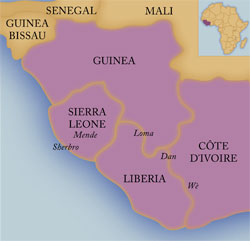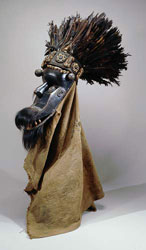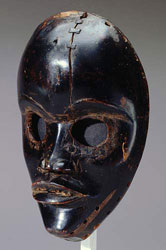

 Sherbro figures represent spirits and serve as sources of
Sherbro figures represent spirits and serve as sources of  power and healing for sacred societies. These figures share regional stylistic features, such as ridged hairstyles and diamond-shaped faces, yet also illustrate inventive approaches to the human form.
power and healing for sacred societies. These figures share regional stylistic features, such as ridged hairstyles and diamond-shaped faces, yet also illustrate inventive approaches to the human form. Dan masks are tools of communication between the world of the living and the realm of the ancestors. They are employed to resolve problems of all kinds. Face masks have idealized human features that are smoothly sculpted with a large domed forehead, a fine nose, and slightly modeled cheekbones. Masks appear frequently during initiation ceremonies and to welcome guests to the village.
Loma masks are used during men's initiation rituals. Worn as part of an ensemble of raffia, cloth, shells and fibers, Loma masks are believed to bring individuals into contact with forces that provide spiritual protection.



